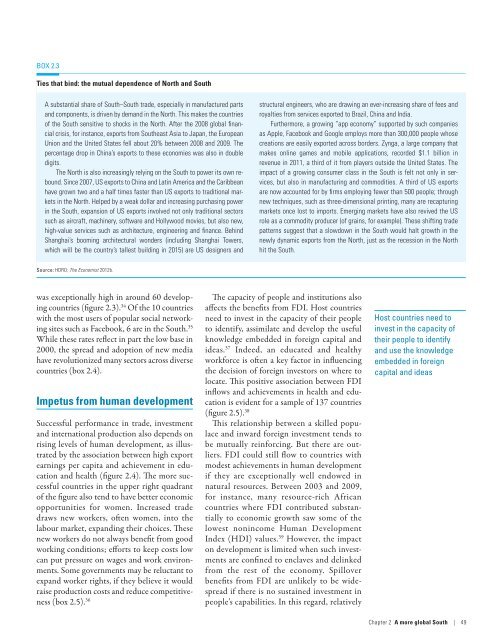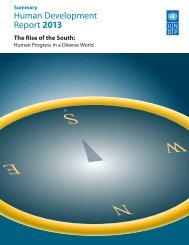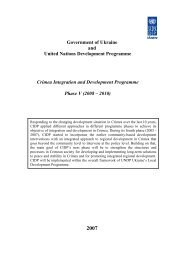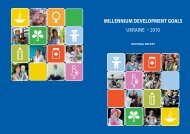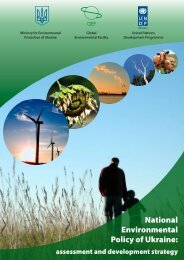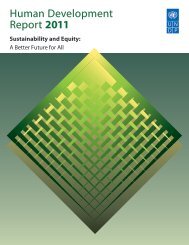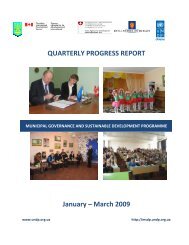E N S W - United Nations Development Programme
E N S W - United Nations Development Programme
E N S W - United Nations Development Programme
You also want an ePaper? Increase the reach of your titles
YUMPU automatically turns print PDFs into web optimized ePapers that Google loves.
Box 2.3<br />
Ties that bind: the mutual dependence of North and South<br />
A substantial share of South–South trade, especially in manufactured parts<br />
and components, is driven by demand in the North. This makes the countries<br />
of the South sensitive to shocks in the North. After the 2008 global financial<br />
crisis, for instance, exports from Southeast Asia to Japan, the European<br />
Union and the <strong>United</strong> States fell about 20% between 2008 and 2009. The<br />
percentage drop in China’s exports to these economies was also in double<br />
digits.<br />
The North is also increasingly relying on the South to power its own rebound.<br />
Since 2007, US exports to China and Latin America and the Caribbean<br />
have grown two and a half times faster than US exports to traditional markets<br />
in the North. Helped by a weak dollar and increasing purchasing power<br />
in the South, expansion of US exports involved not only traditional sectors<br />
such as aircraft, machinery, software and Hollywood movies, but also new,<br />
high-value services such as architecture, engineering and finance. Behind<br />
Shanghai’s booming architectural wonders (including Shanghai Towers,<br />
which will be the country’s tallest building in 2015) are US designers and<br />
structural engineers, who are drawing an ever-increasing share of fees and<br />
royalties from services exported to Brazil, China and India.<br />
Furthermore, a growing “app economy” supported by such companies<br />
as Apple, Facebook and Google employs more than 300,000 people whose<br />
creations are easily exported across borders. Zynga, a large company that<br />
makes online games and mobile applications, recorded $1.1 billion in<br />
revenue in 2011, a third of it from players outside the <strong>United</strong> States. The<br />
impact of a growing consumer class in the South is felt not only in services,<br />
but also in manufacturing and commodities. A third of US exports<br />
are now accounted for by firms employing fewer than 500 people; through<br />
new techniques, such as three-dimensional printing, many are recapturing<br />
markets once lost to imports. Emerging markets have also revived the US<br />
role as a commodity producer (of grains, for example). These shifting trade<br />
patterns suggest that a slowdown in the South would halt growth in the<br />
newly dynamic exports from the North, just as the recession in the North<br />
hit the South.<br />
Source: HDRO; The Economist 2012b.<br />
was exceptionally high in around 60 developing<br />
countries (figure 2.3). 34 Of the 10 countries<br />
with the most users of popular social networking<br />
sites such as Facebook, 6 are in the South. 35<br />
While these rates reflect in part the low base in<br />
2000, the spread and adoption of new media<br />
have revolutionized many sectors across diverse<br />
countries (box 2.4).<br />
Impetus from human development<br />
Successful performance in trade, investment<br />
and international production also depends on<br />
rising levels of human development, as illustrated<br />
by the association between high export<br />
earnings per capita and achievement in education<br />
and health (figure 2.4). The more successful<br />
countries in the upper right quadrant<br />
of the figure also tend to have better economic<br />
opportunities for women. Increased trade<br />
draws new workers, often women, into the<br />
labour market, expanding their choices. These<br />
new workers do not always benefit from good<br />
working conditions; efforts to keep costs low<br />
can put pressure on wages and work environments.<br />
Some governments may be reluctant to<br />
expand worker rights, if they believe it would<br />
raise production costs and reduce competitiveness<br />
(box 2.5). 36<br />
The capacity of people and institutions also<br />
affects the benefits from FDI. Host countries<br />
need to invest in the capacity of their people<br />
to identify, assimilate and develop the useful<br />
knowledge embedded in foreign capital and<br />
ideas. 37 Indeed, an educated and healthy<br />
workforce is often a key factor in influencing<br />
the decision of foreign investors on where to<br />
locate. This positive association between FDI<br />
inflows and achievements in health and education<br />
is evident for a sample of 137 countries<br />
(figure 2.5). 38<br />
This relationship between a skilled populace<br />
and inward foreign investment tends to<br />
be mutually reinforcing. But there are outliers.<br />
FDI could still flow to countries with<br />
modest achievements in human development<br />
if they are exceptionally well endowed in<br />
natural resources. Between 2003 and 2009,<br />
for instance, many resource-rich African<br />
countries where FDI contributed substantially<br />
to economic growth saw some of the<br />
lowest nonincome Human <strong>Development</strong><br />
Index (HDI) values. 39 However, the impact<br />
on development is limited when such investments<br />
are confined to enclaves and delinked<br />
from the rest of the economy. Spillover<br />
benefits from FDI are unlikely to be widespread<br />
if there is no sustained investment in<br />
people’s capabilities. In this regard, relatively<br />
Host countries need to<br />
invest in the capacity of<br />
their people to identify<br />
and use the knowledge<br />
embedded in foreign<br />
capital and ideas<br />
Chapter 2 A more global South | 49


